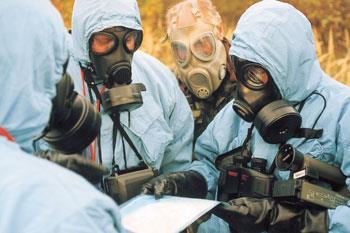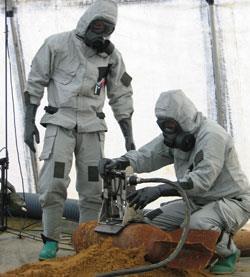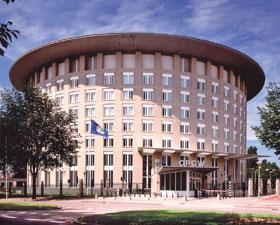It is almost a decade since the Chemical Weapons Convention came into force but many signatories are failing to meet targets. Simon Hadlington investigates.
It is almost a decade since the Chemical Weapons Convention came into force but many signatories are failing to meet targets. Simon Hadlington investigates.
In March this year in Kambarka, a town in the Udmurt republic about 2000km east of Moscow, Russia, a significant event took place that marks another closing chapter in one of science’s less glorious stories.
President Putin officially opened Kambarka’s new chemical weapons decommissioning facility, where some 6000 tonnes of the arsenic-based blistering agent lewisite will be destroyed.

The Kambarka operation is part of the Russian Federation’s pledge to destroy its declared stockpile of 40,000 tonnes of chemical weapons as a signatory to the Chemical Weapons Convention (CWC). This international agreement to rid the world of chemical weapons came into force in 1997 and has been singed by almost every country in the world. Originally the convention envisaged that the signatories would have destroyed all their weapons by 2007. However progress has been slow in some countries and the original deadlines will need to be revised by some years.
Just as chemists played a key role in developing these poisons, they are now closely involved in destroying them as cleanly and safely as possible.
There are broadly two categories of chemical weapon that require disposing of: old weapons left over from previous conflicts that are on the battlefield, on firing ranges, or that had been dumped or abandoned; and stockpiled weapons, largely remaining from the cold war.
Military toxins
The morbidly fascinating tale of modern chemical warfare probably started on 22 April 1915 at Ypres, on the western front, when German troops opened cylinders of chlorine, allowing the gas to drift over to the allies’ positions.
The deployment of new poisons rapidly followed. ’Essentially the chemists of the day went along the shelf, picked out all the nasty things they knew about and tried them,’ says Richard Soilleux, technical leader for chemical demilitarisation at the UK government’s Defence Science and Technology Laboratory (DSTL) at Porton Down in Wiltshire and one of the UK’s leading experts on chemical weapons and their decommissioning.
Carbonyl chloride - phosgene - was soon being used, a heavy gas that would drift down into enemy trenches. ’The Germans would have banks of cylinders dug into the ground,’ says Soilleux. ’They would wait until the wind was in the right direction then open the taps and empty the cylinders. If the wind was in the right direction, this was a very effective weapon. But if the wind changed and blew it back, then that was a problem.’
To counteract this issue, poisons started to be deployed in shells. A hole would be drilled in a high explosive shell and the cavity filled with, for example, mustard gas - bis(2-chloroethyl)sulfide - an oily liquid which evaporates slowly and which causes severe burning and blistering.
The British, in turn, developed the Livens projector, short gas cylinders containing burster tubes that were launched by mortar. When charged with chlorine or phosgene, these were extremely effective.
Mustard and phosgene continued to be used in the second world war, but a new innovation was the development of nerve agents.
’The Germans invented nerve agents, based on insecticide research,’ says Soilleux. ’The allies did not have them, although the Germans assumed we did because they knew from the research literature that we did have the precursors.’ The nerve agents were given the prefix ’G’ for ’German’ and comprised mainly tabun (GA, ethyl N,N-dimethylphosphoramidocyanidate), sarin [GB, 2-(fluoromethyl phosphoryl)oxypropane], and in lesser amounts, soman [GD, 3-(fluoromethylphosphoryl)oxy-2,2-dimethylbutane].
Although stockpiled by the Germans, the nerve agents were not used. Towards the end of the first world war, the Americans invented lewisite, an oily arsine consisting mainly of 2-chlorovinylarsonous dichloride that is a blister-forming agent in its own right, but generally used as an antifreeze for mustard, mainly by the Russians and Japanese.
Meanwhile the Japanese took large quantities of chemical weapons into China during the 1930s and in the second world war, including mustard-lewisite mixtures, DA (diphenylchloroarsine) and DC (diphenylcyanoarsine). These were abandoned after the war and buried in a remote area in the north east of China. It is thought that there could be half a million rounds of chemical-containing munitions remaining there.
’After the second world war there were huge quantities of chemical weapons both contained in munitions and stored in bulk in the UK and around the world,’ Soilleux says. Further stockpiles were accumulated during the 1950s and 1960s at the height of the cold war, by both the US and the Soviet Union, including new nerve agents such as VX, O-ethyl-S-(2-diisopropylaminoethyl)methylphosphonothioate.
Cleaning up the mess
The CWC requires all signatories (which is essentially every country in the world, apart from one or two such as Syria and North Korea) to dispose of chemical weapons and their production facilities. This includes both old and abandoned weapons, as well as stockpiles.
The technicalities of disposing of chemical weapons depends largely on local issues such as environmental regulations. Some destruction processes are prohibited by the convention, including dumping at sea or burning in open pits. ’But apart from these restrictions it is largely up to the individual country to decide how to go about the decommissioning process within its own legislation,’ says Soilleux.
During less enlightened times and before the convention, dumping at sea was one approach for most of the material remaining from the first and second world wars. ’This has left a serious legacy in the Baltic, where corroded drums of decomposing material are regularly dredged up by fishing nets in the shallower waters,’ says Soilleux. In the UK in the 1950s, large quantities of material were either sealed in old hulks and sunk in the North Sea, or burned in open pits. This has left a problem of contaminated land.
The world’s two main reserves of stockpiled weapons are those accumulated by the US and the former Soviet Union, with each country declaring some 40,000 tonnes.
’Probably the biggest non-stockpiled problem is that faced by the Japanese, with the abandoned weapons in China,’ says Soilleux.
France and Belgium have a significant problem with old chemical weapons, with some 400 tonnes (including metal casings) of munitions from old battlefields recovered each year in France, around a tenth of which are chemical weapons.
Disposal technologies
The most straightforward way to destroy chemical weapons is by simple incineration. ’This is certainly effective in destroying the compounds, but there is an issue of what comes off,’ says Soilleux. ’One of the guiding principles here is not to do anything to the chemicals that will add to the environmental burden.’
Early incineration technology usually subjected the material to a single burn, and put some fairly noxious fumes into the atmosphere. Modern techniques use scrubbing systems and incorporate a second, higher-temperature burn to finish off any residues.

’There is a public aversion to incineration, and the US in particular has put a lot of effort into developing alternative technologies for disposing of these chemicals,’ Soilleux says.
Most chemical warfare agents are susceptible to oxidation. Bleach is effective but releases chlorine. Other methods involve using hydrogen peroxide or supercritical water - water at high temperature and pressure.
Mustard is susceptible to hydrolysis by water at 90?C, producing mainly thiodiglycol and hydrochloric acid. The latter can be neutralised with sodium hydroxide while the former is a substrate for certain microbes and can be fed into a microbial digester.
’This technique was developed in the US for those states where the legislation does not permit incineration,’ says Soilleux. ’Hot water hydrolysis followed by biological digestion has accounted for some 2000 tonnes of mustard.’
One solution developed by Accentus, a former subsidiary of UK firm AEA Technology, was silver(ii) electrochemical oxidation. Here, electrolysis of silver nitrate in concentrated nitric acid produces silver ions in their second oxidation state, a highly powerful oxidising system which will easily tear up organic molecules. ’We tested it here at Porton Down and put a considerable effort into proving the technology,’ Soilleux says. ’It is effective, it does work but it is technically very complex.’ Accentus has since discontinued work on the technology.
Another method that was investigated was simple acid digestion, where the entire munition - metal casing plus contents - is placed in a bath of concentrated nitric acid which destroys both the steel and the agent. The problem here is the creation of a large amount of effluent and the need to recycle the acid. ’The odd detonation can also be triggered,’ Soilleux says. ’It was abandoned.’
With arsenic-containing agents there is a problem because arsenic is persistent in the environment. During incineration of such compounds, scrubbing systems are used to capture the arsenic oxide - itself a difficult material to handle because it sublimes. This is then reacted with sodium hydroxide to yield sodium arsenate, which is then usually immobilised in concrete or glass.
Russia has developed its own two-step process for dealing with its considerable stockpiles of nerve agents. First the agent is neutralised and detoxified with a cocktail of organic compounds. This is then mixed with bitumen, placed in sealed drums and buried.
International aid for Russia’s destruction programme
The UK, US, Canada and other donor nations are helping Russia to meet its targets under the Chemical Weapons Convention.
A facility at Shchuch’ye, in the Urals, is well underway, with completion expected in 2008. This will tackle an arsenal of some 5440 tonnes of nerve agent contained within 1.9 million artillery and rocket-launched munitions.
The UK expects to contribute around ?25 million to Shchuch’ye, providing electricity infrastructure and procurement of equipment for the destruction process.
Construction of a new facility at Kizner, 1000 km east of Moscow, is due to start next year to dispose of two million artillery munitions loaded with nerve agent. Russia has the world’s largest declared stockpile of chemical weapons, with more than 40,000 tonnes stored at seven sites in western Russian, most of which consists of modern nerve agents and munitions.
Old weapons
The disposal of old, non-stockpiled weapons brings its own challenges, as Soilleux explains. ’With stockpiled munitions it is relatively simple to unscrew the shell, remove the agent and dispose of it. But for something that has been lying in the ground for 50 years and the agent has polymerised into a tar-like mess, this is not so simple.’

When old munitions are discovered in the UK they are sent to Porton Down for disposal. Soilleux describes the procedure: ’When we get an old shell in, the first thing we do is label it, give it a PIN and report it to the Organisation for the Prohibition of Chemical Weapons (OPCW), which oversees the Chemical Weapons Convention’. The shell is next x-rayed to yield information about its internal structure and mechanisms, whether it has been fired and whether it contains liquid.
The shell is then subjected to neutron activation analysis, where neutrons are fired into the shell and the gamma rays that are emitted are characteristic of the contents. ’From the gamma-ray spectrum we can obtain information about the presence and ratios of atoms such as chlorine, sulfur and phosphorus,’ Soilleux says. ’From the atomic ratios you can have a pretty good idea of what is in there. The main thing is to find out if there is any high explosive in the shell or any white phosphorus. If there isn’t, we usually also drill the shell and take a small sample for a more thorough analysis. This is to determine if there is any arsenic in the sample, which we would not want to go through our incinerators.’
This process is labour intensive and costly. So scientists in the US, Japan and Sweden have come up with a simpler, more direct route to destroy these shells and their contents: the detonation chamber.
Soilleux explains: ’Essentially you put the entire munition in a detonation-proof chamber, close the door and blow it up. There is a momentary massive rise in temperature and pressure - for milliseconds - which is sufficient to degrade the explosive and most of the chemical extremely quickly. You then need an afterburner and/or gas cleaning system just to get rid of any residual chemical.’
The French are planning to build an automated destruction facility based on a detonation chamber.
Detecting chemical weapons in Iraq
Although the UK and US famously failed to find chemical weapons in Iraq following the fall of Saddam Hussein, there is evidence that chemical weapons were used against the Kurdish people in 1988. One of these attacks took place in the village of Birjinni, Iraq.
Alastair Hay, from the molecular epidemiology unit at the University of Leeds, UK, along with the Defence Science and Technology Laboratory (DSTL), Porton Down, helped coordinate a study of soil samples from Northern Iraq, which was the first to prove that an atrocity had taken place.
Working with Physicians for Human Rights, Middle East Watch (a division of Human Rights Watch), and UK journalist Gwynne Roberts, Hay received the samples, taken in 1988 and 1992 from bomb craters, and passed them to DSTL.
Scientists at Porton Down used gas chromatography-mass spectrometry with selective ion monitoring to measure the intensities of several specific ion beams originating from volatile compounds in the sample. From the data, Hay was able to confirm the presence of the nerve gas sarin and its characteristic breakdown products, including isopropyl methyl phosphonic acid. Mustard gas was also detected, along with its hydrolysis product thiodiglycol. Degradation products specific to mustard gas were also found including 1,4-thioxane, 1,4-dithiane, along with the common chemical weapon explosive tetryl. ’Because the agents had been blasted into the ground they were still at a high enough concentration in the soil four years after they had been used,’ Hay told Chemistry World.
Tom Westgate
Chemical future
Gradually, the chemicals that have been accumulating are slowly depleting, albeit more slowly than had been envisaged by the CWC when it came into force almost a decade ago. At the time, the ambitious target was for all stockpiled weapons to have been destroyed within 10 years. As things stand, fewer than 20 per cent of all declared weapons have been disposed of so far. There are provisions for extensions to 2012, and the US has just drafted a request to extend its destruction deadline to that date, conceding that even if the extension is granted it is unlikely to be met.
However, according to Rogelio Pfirter, director general of the OPCW, it is vital that these weapons continue to be destroyed. ’Now over 90 per cent of the world’s governments are implementing the Chemical Weapons Convention,’ he told Chemistry World. ’Billions are invested in the destruction and demilitarisation process. Member states, and especially possessor states parties, know that the declared chemical weapons production capacity must be eliminated within the convention’s timelines. The declared stockpile of munitions and agents is gigantic and the destruction processes are quite complex. It is inevitable that delays will occur. The six possessor states are staying the course and have reiterated their commitment to fulfil the convention’s stipulations in full and on time. We urge them to continue in the same way and to spare no effort, no matter what the difficulties, to destroy these weapons within the agreed timeframes. The credibility and deterrence value of the convention depends upon its full implementation.’
Richard Soilleux, who has spent 30 years in chemical defence research and the past 10 on demilitarisation, remains optimistic. ’It will be some years before all these weapons are destroyed, but this is the first treaty which has banned a whole class of weapons that has been signed up to by almost every country in the world,’ he says. ’I do believe that there is a political will to make it happen, and I am personally pleased to have been associated with it over the past few years.’
Simon Hadlington is a science writer based in York, UK
- Bruker Daltronics, part of Bruker, US, sells devices to several armed forces and security services. The range includes systems that use infrared and ion mobility spectrometry (IMS) to detect, identify and quantify chemical agents. The firm also makes a portable neutron induced gamma spectrometry unit, on which shells can be mounted directly without risking release or detonation.
- Advanced Measurement Technology, Tennessee, US, part of Ametek, US, supplies the ORTEC range of equipment for detection and spectroscopy of radionuclides, including gamma spectroscopy systems and portable devices.
- Smith Detection, part of the global bioengineering company, Smiths group, UK, provides a chemical agent monitor based on IMS. It was the first mass-produced hand-held instrument for detecting compounds such as nerve agents and is deployed by armed forces worldwide.
- Proengin, France, designs and manufactures chemical detectors based on flame spectrometry. Its hand-held detectors, including the AP2C, can be used to monitor chemical agents in vapour or liquid.
- MMIC EOD, based in the UK, produces devices for handling and storing munitions. These include the ’Monica’ remote case entry and sampling system. The Defence Science and Technology Laboratory, UK, helped develop the Monica and it is used by a number of other military and special forces worldwide. The device drills through target casings and inserts a gas-tight, self-sealing probe, allowing safe sample removal.
- Cascade Technologies, Stirling, UK, has developed a quantum cascade laser gas analyser. The company, launched in 2004 as a spin-off from the University of Strathclyde, UK, recently secured ?2.5 million in funding to help it diversify into the defence market.






No comments yet